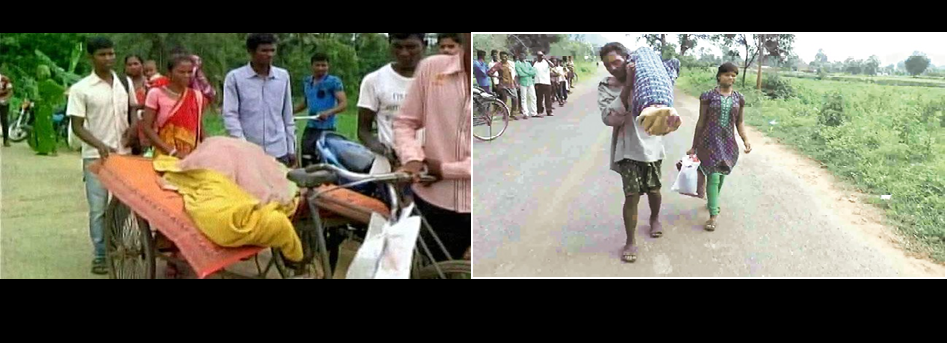No Health Care for The Poor in India, They Are Expendable

NEW DELHI: The story of a tribal woman, Pana Tirika, whose family had to carry her dead body in a trolley rickshaw from the district hospital to her village in Odisha, made frontpage news recently. The district hospital in Jajpur was slammed for not being able to provide an ambulance to transport the dead body back to the village. The incident received widespread attention as it came on the heels of the horrifying images and videos of Dana Majhi -- who is seen carrying his dead wife, wrapped in pieces of cloth over his shoulder, for cremation. Alongside Majhi walked his 12 year old traumatised child, for 10 kilometers to Melaghar.
The images and videos of Dana Majhi attracted the international as well as the national media attention through which, the Bahraini Prince, Akhbar Al Khaleej, contacted the Indian Embassy in Bahrain and made a donation to the aggrieved family, even before the government of Odisha reacted to the reported incident. The district collector of Kalahandi later, claimed to have extended economic assistance, under the ‘Harishchandra Yojana’ scheme to the family.
These incidents have been reported widely, prompting the state government to respond. In Odisha, an official launch of mortuary vehicle to carry bodies of the poor -- from hospital to their village -- had already taken place in February this year. Yet, the most appalling and outrageous incidents of failed public health care facilities stare us in the face even as Chief Minister, Naveen Patnaik, launches such schemes and the ambulance withdraws service, as soon as the patient breathes her last. The case of a seven year old girl, left midway to the Malkangiri district hospital, after succumbing to her deteriorating health condition is yet another instance that highlights the callous and irresponsible attitude of public health care services, for the deprived and the needy in this country.
The government of Odisha was yet again left red-faced when an 80 year old woman’s dead body was broken and slung to a pole -- in order for it be carried back to Balasore, for cremation. Earlier, in the month of August, several incidents of neglect in the public healthcare system were reported in the state of Odisha, where in one such incident, a man was forced to get off the bus along with his five year old child, after his wife died in the vehicle.
Amongst several schemes of the state government of Odisha, the ‘Biju Gaon Gari Yojana’ launched in the year 2014, operational in 12 districts of the state of Odisha, is largely unavailable or non-existent. The Biju Krushak Kalyan yojna claims to provide health insurance cover to farmers and their families in rural Odisha. These yojnas and schemes that have existed in the country for a decade have not been implemental in their entirety, as reports of discrimination expand.
The situation outside of Odisha is the same. Recently, an equally disturbing video emerged in the media. Taken in Kanpur, the video showed a 12 year old who was carried by his helpless father, on his shoulder, to the next hospital, after being denied admission into the government-run Lala Lajpat Rai Hospital. Even as the child was declared dead by the children’s hospital he was then taken to, no transport services were provided to Mr. Kumar, who carried the dead body of his son back home, on his shoulders.
These dire and appalling incidents of inequitable treatment to the rural population of India violate the conditions laid by the government of India, in its National Health Policy, 2015. The Draft National Health Policy of 2015 puts forward its goals under various sub categories to ensure equity, universality, subsidiarity, accountability, availability as well as affordability, among other categories, and these have failed to reach out to the people in India. A concentrated look into the policy finds elaborate explanations and goals that are to be implemented through the private sectors of health care, while public sectors are purely ignored and minimally represented.
Healthcare has become one of the largest sector in India, but at the same time, dispatching of proper health care facilities at subsidized rates to the population through the public sector has been reduced. The Healthcare industry in India is worth US$ 100 billion and is expected to grow to US$ 200 billion by 2020. According to the Sectorial Report of the Healthcare Industry in India, released in January 2016, various government policies such as the NITI Aayog (National Initiative for Transforming India), National Dialysis Service Program, new health ‘protection’ scheme-covering up to Rs 1 lakh per family, healthcare cover for senior citizens, unique initiatives like ‘Sehat’, have been initiated. Though national reports assert the active role of the government, the actual image unfolds through the heart rending stories that make headlines in several newspapers, only to be forgotten gradually.
Though infringement and abuse of the rights of civilians continue to be a part of the reality, the vigilant population must prompt the government into taking quick, accountable and responsible measures to ensure accessible treatment through its healthcare sectors. The inactive yojnas and schemes cannot be a part of our discussion when such appalling incidents highlight the reality of the public healthcare system of dispensing off its responsibilities.



